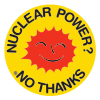Anti-nuclear movement in Kazakhstan

| Anti-nuclear movement |
|---|
 |
| By country |
| Lists |
The anti-nuclear movement in Kazakhstan, "Nevada Semipalatinsk", was formed in 1989 and was one of the first major anti-nuclear movements in the former Soviet Union. It was led by author Olzhas Suleimenov and attracted thousands of people to its protests and campaigns which eventually led to the closure of the nuclear test site at Semipalatinsk in north-east Kazakhstan in 1991.[2][3][4] The movement was named "Nevada Semipalatinsk" in order to show solidarity with similar movements in the United States aiming to close the Nevada Test Site.[5]
The Soviet Union conducted 456 nuclear weapons tests at the Semipalatinsk Test Site, between 1949 and 1989.[4][6] The United Nations believes that one million people around Semipalatinsk were exposed to radiation, and the incidence of birth defects and cancer is much higher than for the rest of the country.[2][3][4]
According to UNESCO, Nevada-Semipalatinsk played a positive role in promoting public understanding of "the necessity to fight against nuclear threats".[7] The movement gained global support and, became "a real historical factor in finding solutions to global ecological problems".[7]
Astana hosted an international conference Building a Nuclear-Weapons-Free World in August 2016. The topics of the conference included nuclear non-proliferation and disarmament and the physical protection of nuclear weapons. The main outcome of the conference was the adoption of The Astana Vision Declaration “From а Radioactive Haze to a Nuclear-Weapon-Free World.”[8]
See also
- Semipalatinsk Test Site
- Downwinders
- Kazatomprom
- Energy policy of Kazakhstan
- List of anti-nuclear power groups
- List of books about nuclear issues
- List of Chernobyl-related articles
- List of nuclear whistleblowers
- List of Nuclear-Free Future Award recipients
References
- ^ Togzhan Kassenova (28 September 2009). "The lasting toll of Semipalatinsk's nuclear testing". Bulletin of the Atomic Scientists.
- ^ a b World: Asia-Pacific: Kazakh anti-nuclear movement celebrates tenth anniversary BBC News, February 28, 1999.
- ^ a b Matthew Chance. Inside the nuclear underworld: Deformity and fear CNN.com, August 31, 2007.
- ^ a b c Krech III, Shepard; Merchant, Carolyn; McNeill, John Robert, eds. (2004). Encyclopedia of World Environmental History. Vol. 1: A–E. Routledge. pp. 70–71. ISBN 978-0-415-93733-7. Retrieved November 23, 2012.
- ^ King, Hannah. Kazakhs Stop Nuclear Testing (Nevada-Semipalatinsk Antinuclear Campaign), 1989-1991. Global Nonviolent Action Database, Swarthmore College, 29 Nov. 2010. Accessed 14 July 2013.
- ^ "Semipalatinsk: 60 years later (collection of articles)". Bulletin of the Atomic Scientists. September 2009. Archived from the original on 2009-10-14. Retrieved 2009-10-01.
- ^ a b Kazakhstan - Audiovisual documents of the International antinuclear movement “Nevada-Semipalatinsk”
- ^ "Anti-Nuclear Weapons Leaders Adopt "Astana Vision Declaration" at Int'l Conference in Astana". astanatimes.com.
